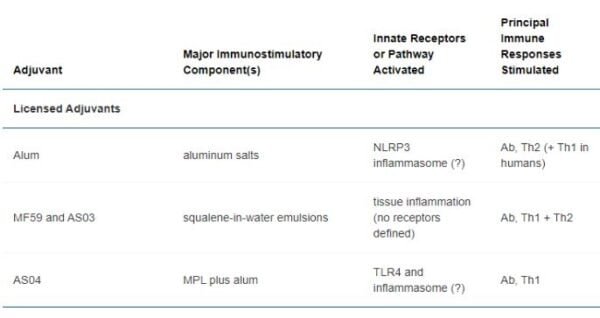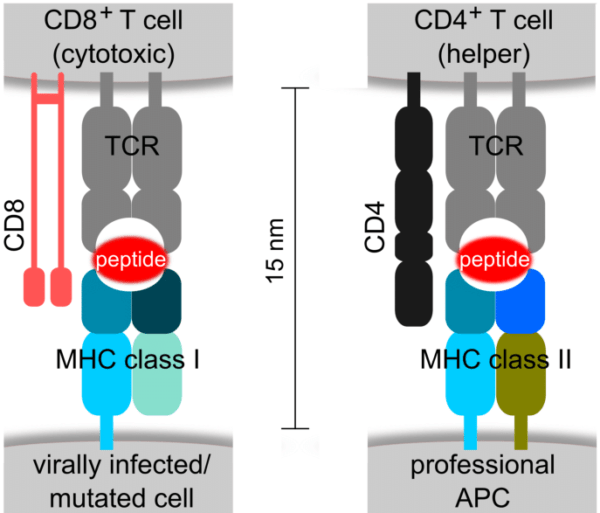Immunology is a field rich in complex interactions between various components of the immune system. Key concepts in this field include immunogen, antigen, and epitope. These terms are fundamental to understanding how the immune system detects and reacts to foreign substances. Moreover, the major histocompatibility complex (MHC) plays a vital role in this process. In this article, we will review these concepts in detail, focusing in particular on the role of MHC class I and class II molecules, their functions in the immune response, and their comparative aspects.
What is an immunogen?
Anne Immunogen Macromolecules capable of eliciting an immune response in an immunocompetent host. This immune response usually involves the production of immunoglobulins (antibodies) or the activation of sensitized lymphocytes. Immunogens are essential for the development of vaccines and for understanding how the body defends against pathogens.
Characteristics of an effective immunogen
- Molecular sizeLarger molecules, generally those with a molecular weight greater than 10,000 daltons, are more likely to be immunogenic. Proteins are particularly potent immunogens because of their size and structural complexity.
- complicatedComplex molecules with multiple structural components (e.g., proteins with tertiary or quaternary structure) are more effective at inducing an immune response than simpler molecules.
- Different: Immunogens must be recognized as foreign by the immune system. The greater the difference between the immunogen and the host’s own molecules, the stronger the immune response.
- Stability and DosageThe stability and dosage of the immunogen may also affect the efficacy of the immune response.
Distinguishing between antigens and immunogens
meanwhile antigen and Immunogen Although related, they have different meanings.
- antigenAn antigen is a substance that does not necessarily provoke an immune response by itself, but is specifically recognized and bound by antibodies or T-cell receptors once an immune response is generated. Essentially, an antigen is the target of an immune response.
- ImmunogenAn immunogen is a substance that actively induces an immune response. All immunogens are antigens, but not all antigens are immunogens.
Factors influencing immunogenicity
The efficacy of an immunogen is influenced by several factors.
- Molecular weight and complexityGenerally, larger and more complex molecules are better immunogens – for example, proteins with multiple epitopes are more effective at eliciting an immune response than smaller, simpler molecules.
- Host age and healthImmune responses vary depending on age and health status. Infants, the elderly, and immunocompromised individuals may respond differently to immunogens.
- Genetic makeupGenetic variation can affect the efficiency of the immune response. For example, a particular genetic profile can strengthen or weaken an individual’s response to a particular immunogen.
- Vaccination routeThe method by which the immunogen is introduced (e.g., intravenous, oral, subcutaneous) influences the nature and strength of the immune response.
Understanding epitopes
Anne Epitope The specific part of an antigen that is recognized by the immune system. Epitopes can be classified as follows:
- Linear epitopes: Consists of linear sequences of amino acids within a protein. These epitopes are recognized by antibodies or T-cell receptors based on their specific sequence.
- Conformational epitopes: formed by the three-dimensional folding of a protein. These epitopes are recognized based on the overall structure of the protein, not just the linear sequence of the protein.
Haptens and their role in immunology
Hapten Haptens are small molecules that are not immunogenic by themselves, but can elicit an immune response when conjugated to a larger carrier molecule, allowing the immune system to recognize the hapten as part of a larger foreign entity.
Examples of haptens
- penicillin: In some people, penicillin can bind to proteins in the body and act as a hapten, causing an allergic reaction.
- Poison IvyThe chemical in poison ivy, urushiol, acts as a hapten. When it binds to proteins in the skin, it can cause an allergic reaction called contact dermatitis.
The role of adjuvants in enhancing immune responses
Adjuvants Substances that enhance the immune response to antigens by stimulating the immune system or by increasing the immunogenicity of antigens.
Types of adjuvants
- Alum (aluminum salt)Alum, used in many vaccines, precipitates antigens, prolonging their exposure to the immune system, thereby enhancing the immune response.
- Oil-in-water emulsion: Creates a depo effect, slowly releasing antigens over time and enhancing the immune response.
- Toll-like receptor agonistsThey mimic pathogen-associated molecular patterns to stimulate the innate immune system and enhance adaptive immune responses.

Types of antigens
Antigens can be classified based on their origin.
- AutoantigensThese are self-antigens that belong to the host. In autoimmune diseases, the immune system mistakenly recognizes these self-antigens as foreign, resulting in conditions such as rheumatoid arthritis and lupus.
- AlloantigensThese are antigens that originate from the same species as the host, but are not identical. They are crucial in situations such as blood transfusions and organ transplants, where matching of donor and recipient antigens is important to avoid rejection.
- Foreign antigensThese come from different species and are recognised by the immune system as foreign – for example, bacterial or viral antigens can provoke an immune response.
- Heterophilic antigens: They exist in unrelated species but share structural similarities. For example, some antibodies may cross-react with similar antigens in different species, potentially triggering unexpected immune responses.
Major histocompatibility complex (MHC) and its classes
of Major histocompatibility complex (MHC) A set of molecules displayed on the cell surface that are essential for antigen presentation to T cells. MHC are divided into two major classes.
Class I MHC molecules
Class I MHC molecules They are present on almost all nucleated cells. They play a key role in presenting endogenous antigens (proteins synthesized within the cell) to CD8+ T cells, which are cytotoxic T cells. The main functions and characteristics of class I MHC molecules are:
- Endogenous antigen presentationClass I MHC molecules bind peptides derived from proteins synthesized within the cell and present them to CD8+ T cells, a process that enables the immune system to recognize and eliminate virus-infected or cancer-altered cells.
- structureClass I MHC molecules consist of a heavy chain (alpha chain), a light chain (beta2 microglobulin), and a peptide-binding groove. The heavy chain is anchored in the cell membrane and complexed with beta2 microglobulin.
- Activation of cytotoxic T cellsInteraction of class I MHC-peptide complexes with CD8+ T cells induces a cytotoxic response, resulting in the destruction of infected or abnormal cells.

Class II MHC molecules
Class II MHC molecules They are primarily expressed on professional antigen-presenting cells (APCs) such as dendritic cells, macrophages, and B cells. They are responsible for presenting exogenous antigens (derived from outside the cell) to CD4+ T cells (also called T helper cells). The main characteristics of class II MHC molecules are:
- Presentation of exogenous antigensClass II MHC molecules bind peptides derived from extracellular proteins that are processed and presented by APCs. These peptides are presented to CD4+ T cells, which play a key role in regulating the immune response.
- structureClass II MHC molecules consist of two alpha and two beta chains that form a peptide-binding groove. Both chains are integral to the cell membrane and work together to bind and present peptides.
- T helper cell activationThe interaction of class II MHC-peptide complexes with CD4+ T cells stimulates the production of cytokines that help activate B cells and other immune cells, enhancing the overall immune response.
Comparison of MHC class I and class II
Although class I and class II MHC molecules are both involved in antigen presentation, they differ in several important respects.
- Source of antigenClass I MHC molecules present endogenous antigens (e.g., from intracellular pathogens or cancer cells), whereas class II MHC molecules present exogenous antigens (e.g., from extracellular pathogens that have been internalized and processed by APCs).
- Cell type expressionClass I MHC molecules are present on almost all nucleated cells, allowing broad surveillance of cellular contents, whereas class II MHC molecules are expressed primarily on APCs and focus on the presentation of processed external antigens.
- T cell interactionsClass I MHC molecules interact with CD8+ T cells, which are primarily involved in cytotoxic responses. In contrast, class II MHC molecules interact with CD4+ T cells, which help regulate the immune response through cytokine release and B cell support.
Human leukocyte antigen (HLA) system
of Human leukocyte antigens (HLA) The system is a set of highly polymorphic molecules within the MHC that play a key role in immune recognition. The HLA system includes:
- HLA class IThese include HLA-A, HLA-B, and HLA-C. These molecules present endogenous antigens to CD8+ T cells and are involved in the recognition and elimination of infected and malignant cells.
- HLA class IIThese include HLA-DP, HLA-DQ, and HLA-DR. These molecules present exogenous antigens to CD4+ T cells and are involved in regulating the immune response and aiding in antibody production.
HLA-Disease Associations
Certain HLA types are associated with specific autoimmune diseases.
- HLA-B27: Associated with ankylosing spondylitis and other spondyloarthropathy. The presence of HLA-B27 increases susceptibility to these diseases.
- HLA-DR4: Associated with rheumatoid arthritis and type 1 diabetes. Certain HLA-DR4 alleles confer an increased risk of developing these autoimmune diseases.
HLA typing is crucial in organ transplantation, as matching the HLA types of donors and recipients can reduce the risk of transplant rejection. Additionally, HLA profiles can provide insight into disease susceptibility and guide personalized medical interventions.
Conclusion
The study of immunogens, antigens, and major histocompatibility complexes provides a comprehensive understanding of how the immune system detects and responds to foreign substances. Class I and class II MHC molecules play distinct and complementary roles in antigen presentation, allowing the immune system to effectively recognize and address a wide range of pathogens and abnormal cells. The HLA system further highlights the complexity of immune recognition and its impact on disease and transplantation.
Detailed consideration of these concepts will provide valuable insights into the mechanisms underlying immune responses and potential therapeutic interventions. Continued research and advances in immunology will hopefully enhance our understanding and treatment of immune-related diseases, ultimately improving health outcomes and quality of life.
References
- Janeway, C. A., Travers, P., Walport, M., & Shlomchik, M. J. (2001). Immunobiology: The immune system in health and disease (5th ed.). Garland Science.
- Alberts, B., Johnson, A., Lewis, J., Raff, M., Roberts, K., and Walter, P. (2002). Molecular Biology of the Cell (4th ed.). Garland Science.
- Horton, R., Wilming, LG, Rand, V., Lovering, RC, Bruford, EA, Khodiyar, V., & Dunn, M. (2004). “Extended human MHC gene map” Nature Reviews Genetics5(12), 889-899. doi:10.1038/nrg1495
- Klein, J., & Sato, A. (2000). “HLA system” Immunity12(3), 241-247. doi:10.1016/S1074-7613(00)80140-5
- Rosenberg, S. A., and Restifo, N. P. (2015). “Adoptive cell transfer as personalized immunotherapy for human cancers” Science348(6230), 62-68. doi:10.1126/science.aaa4967







